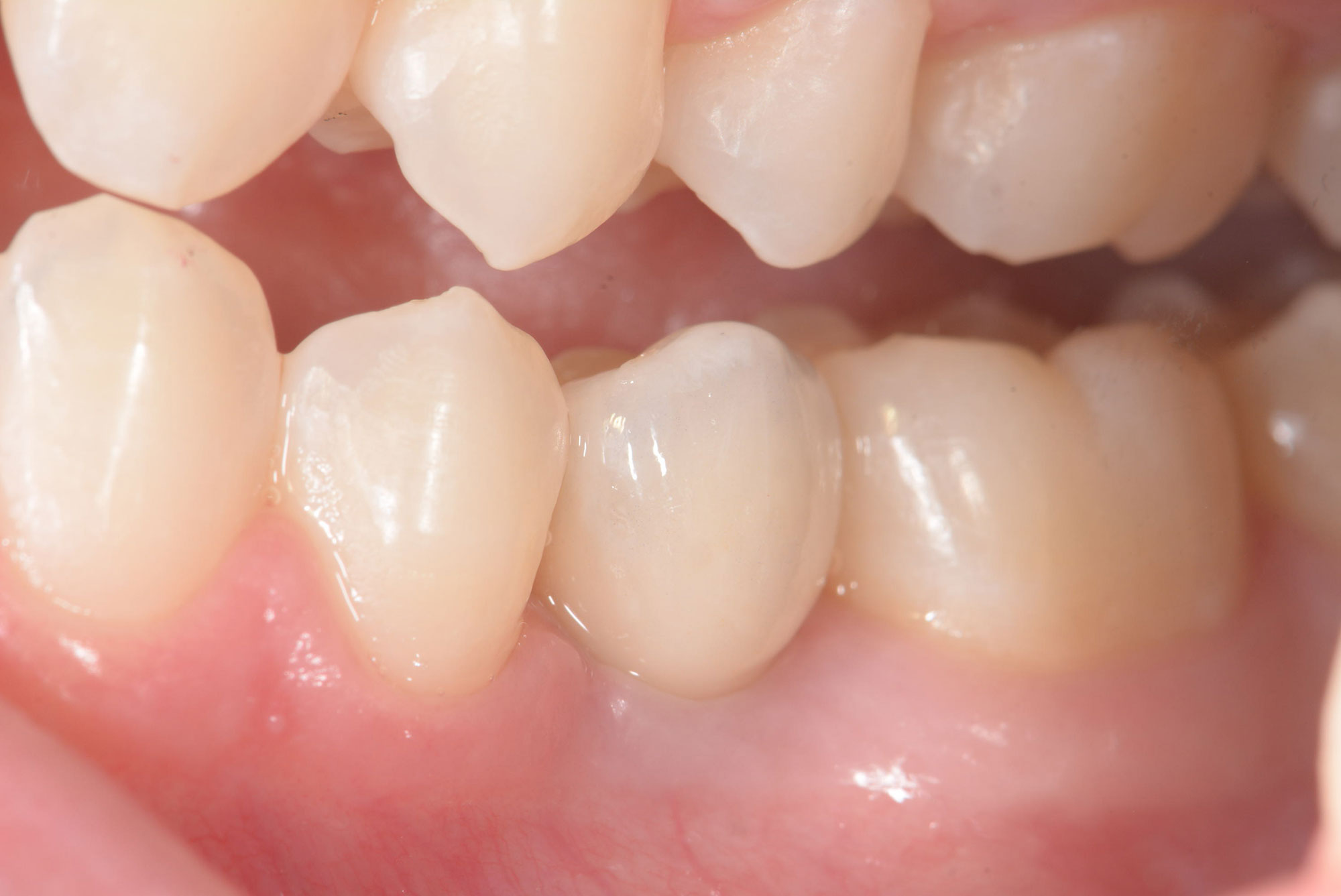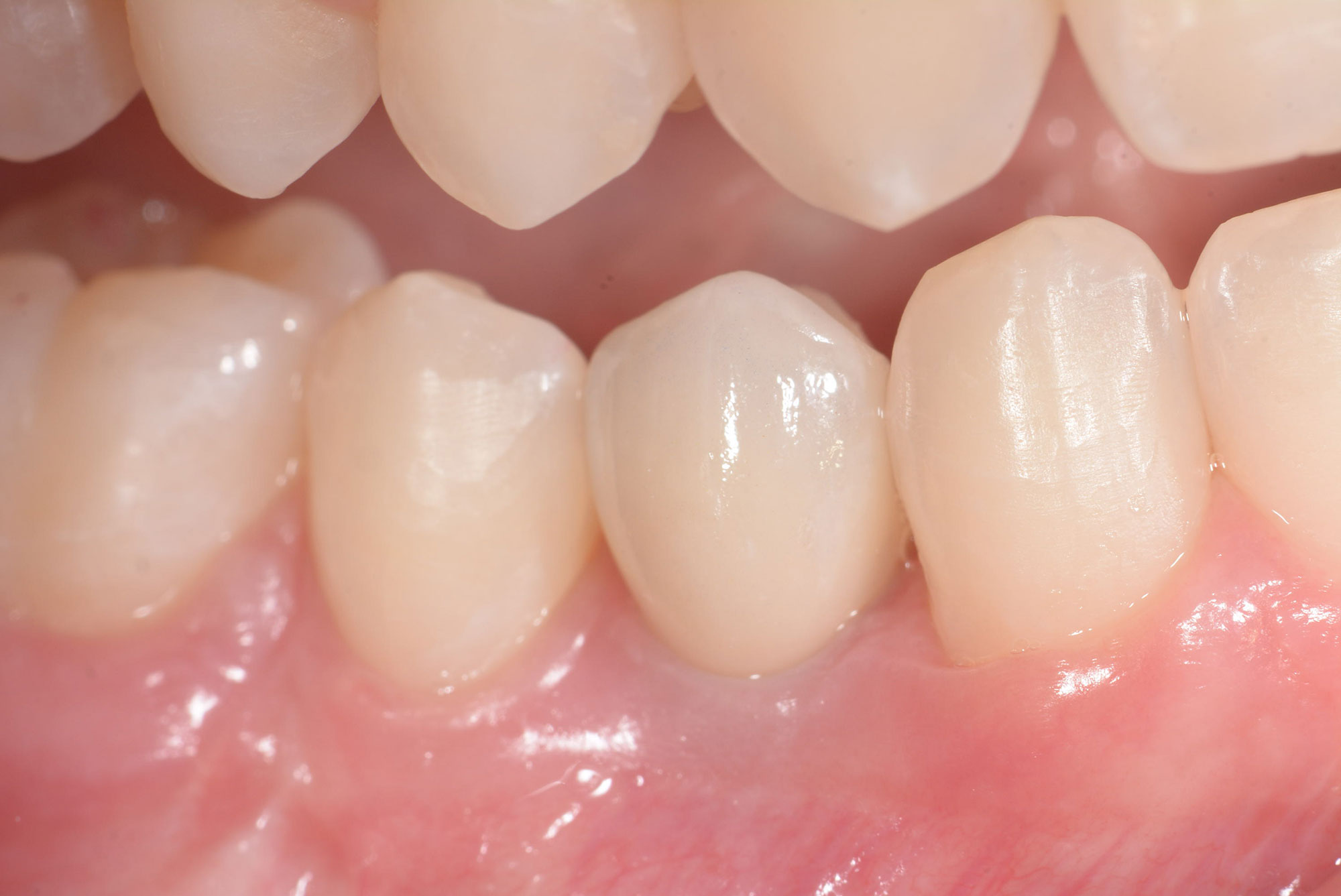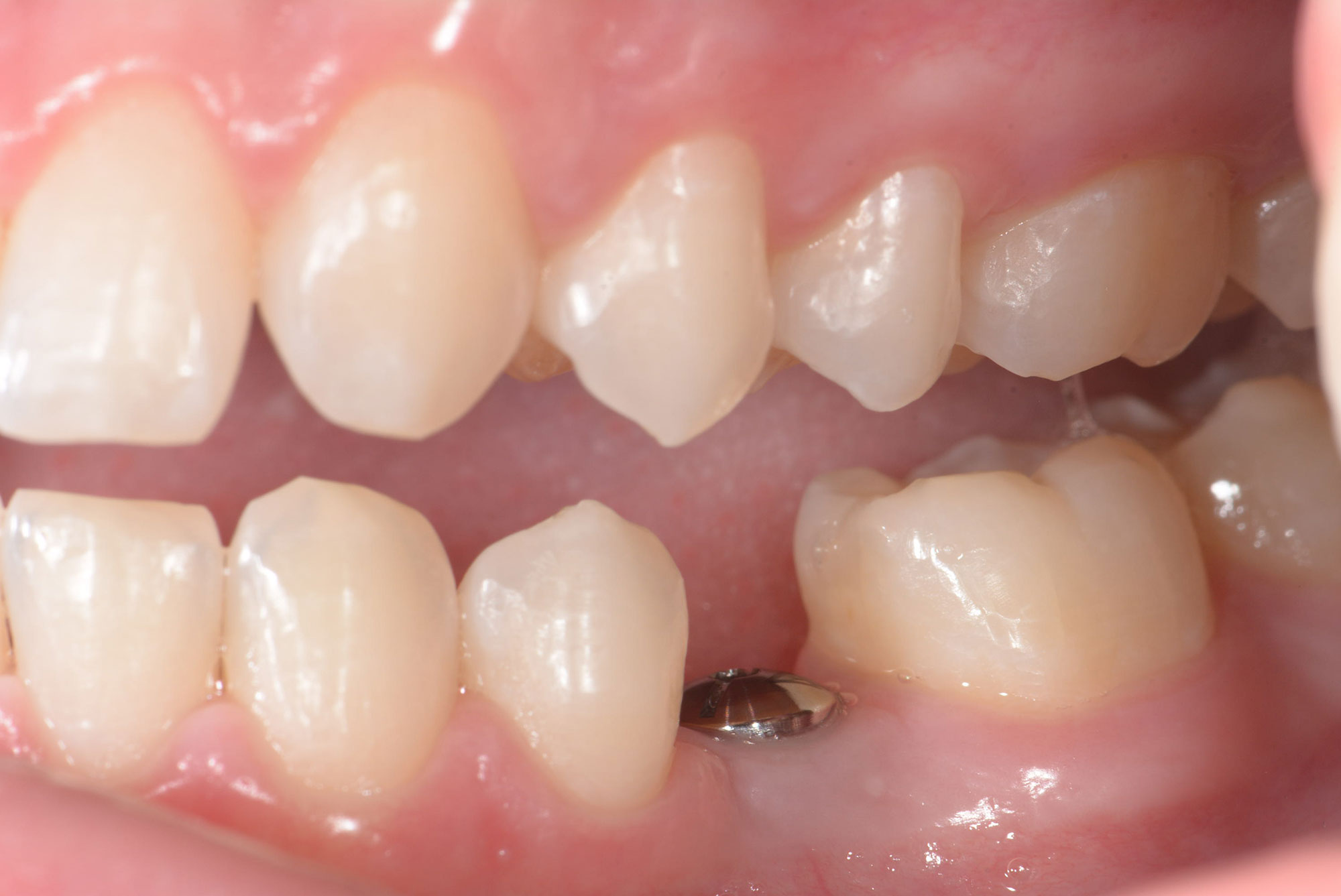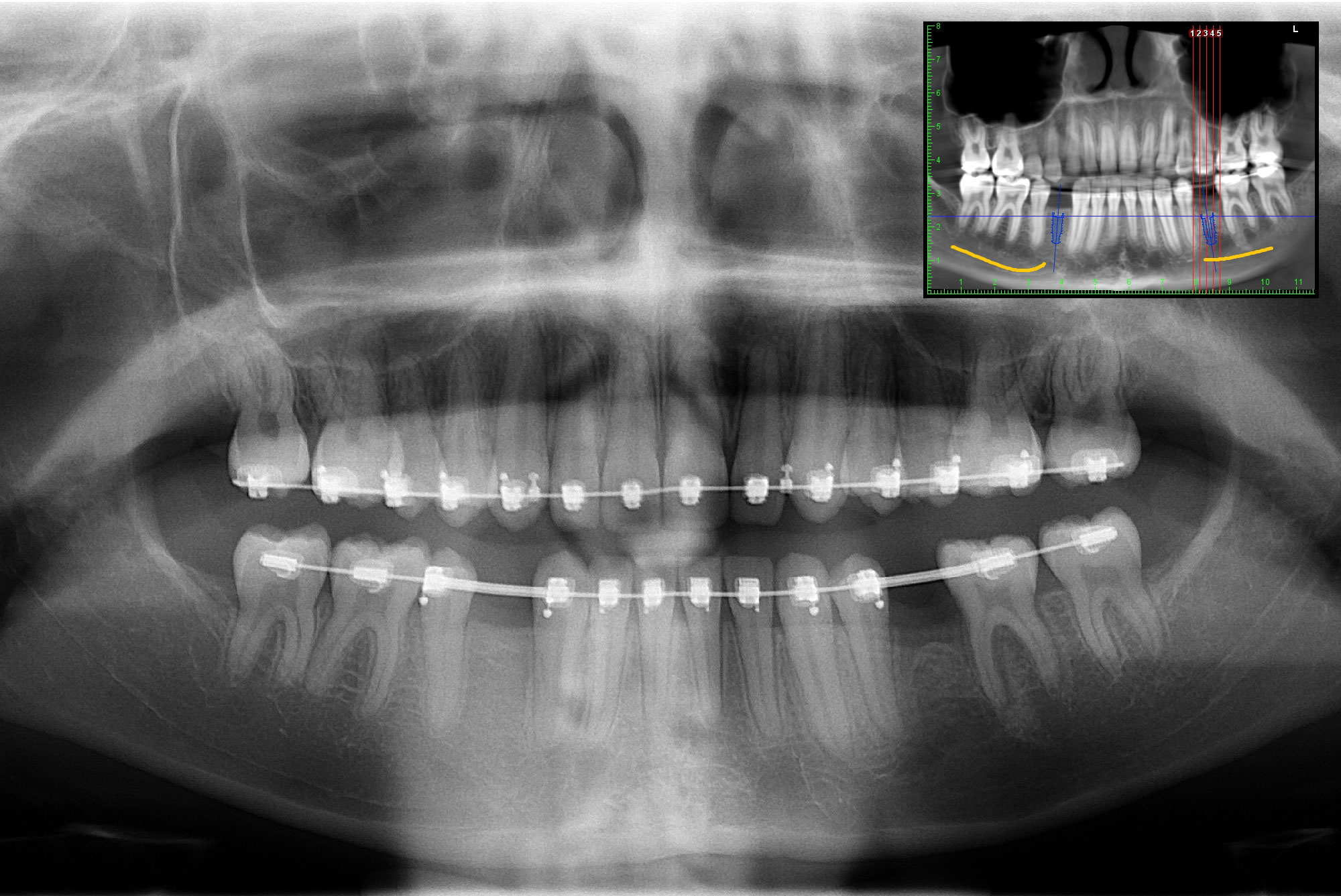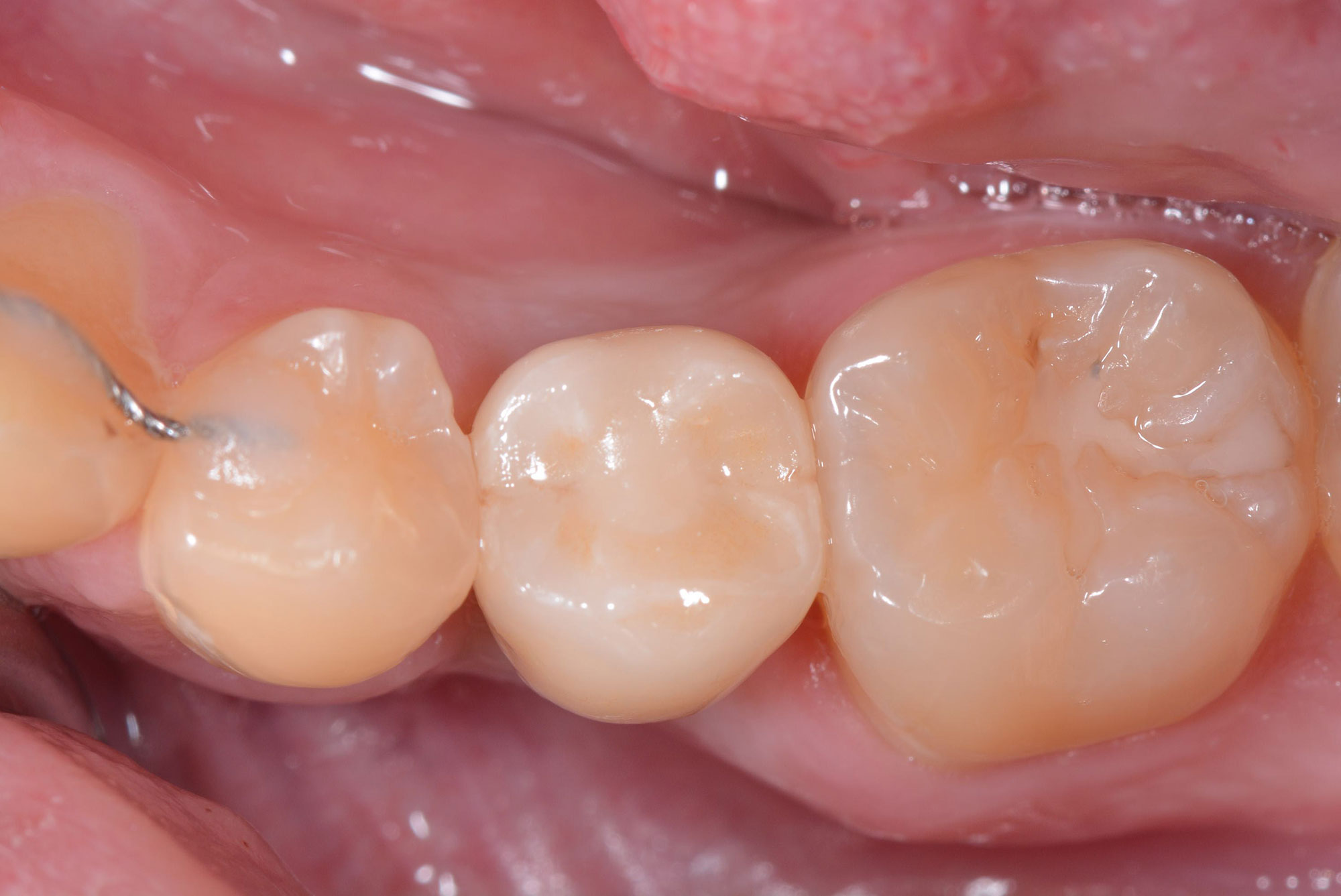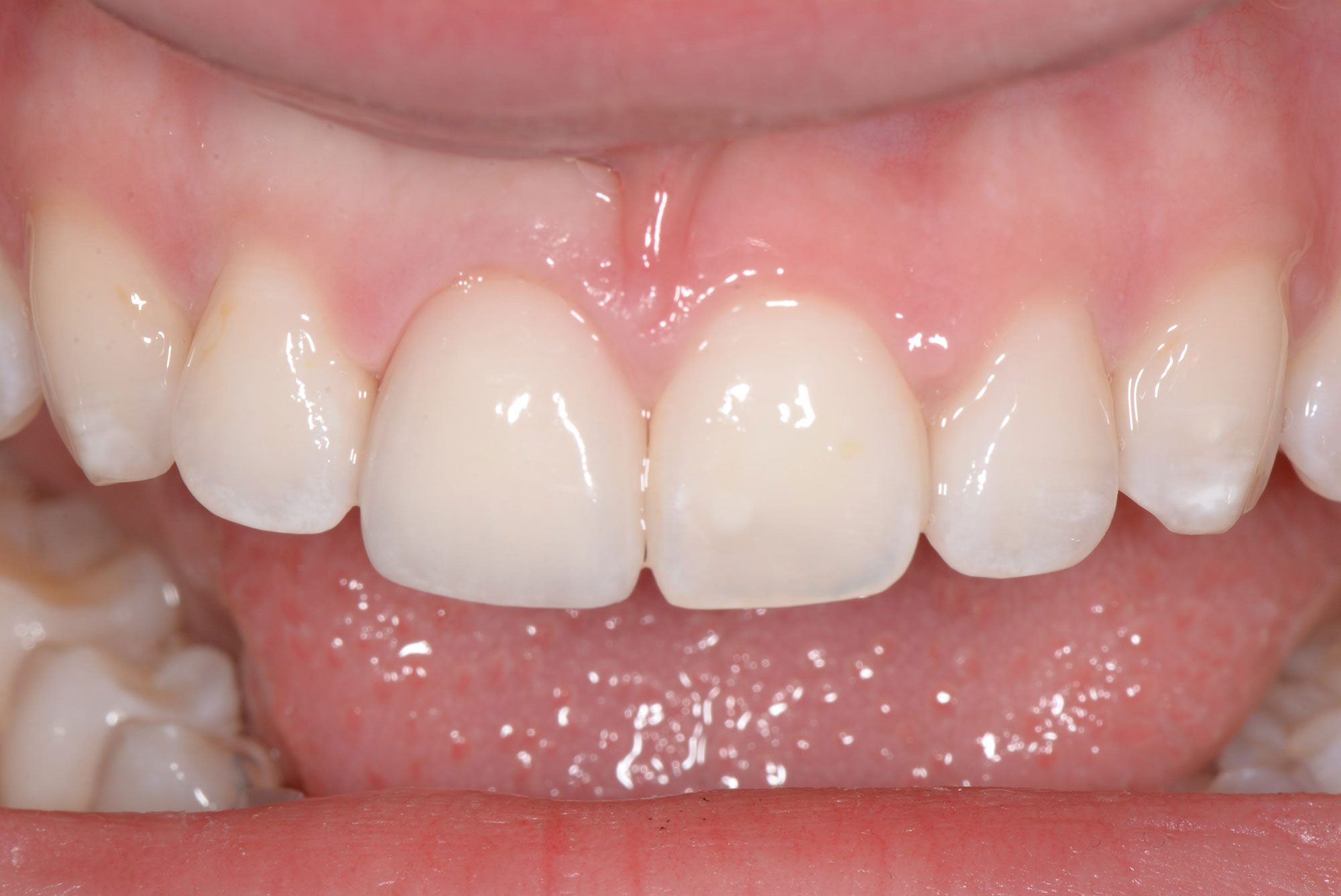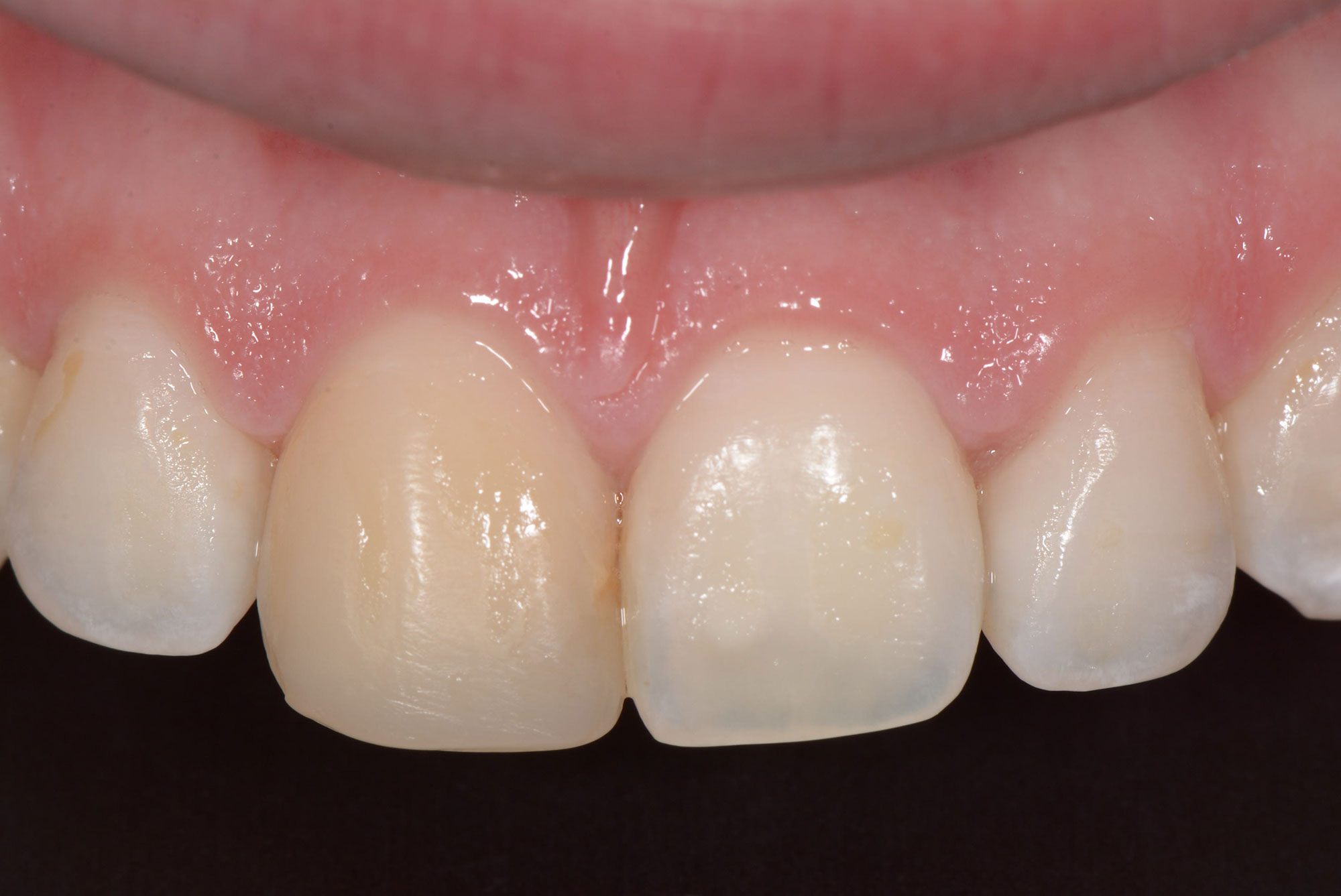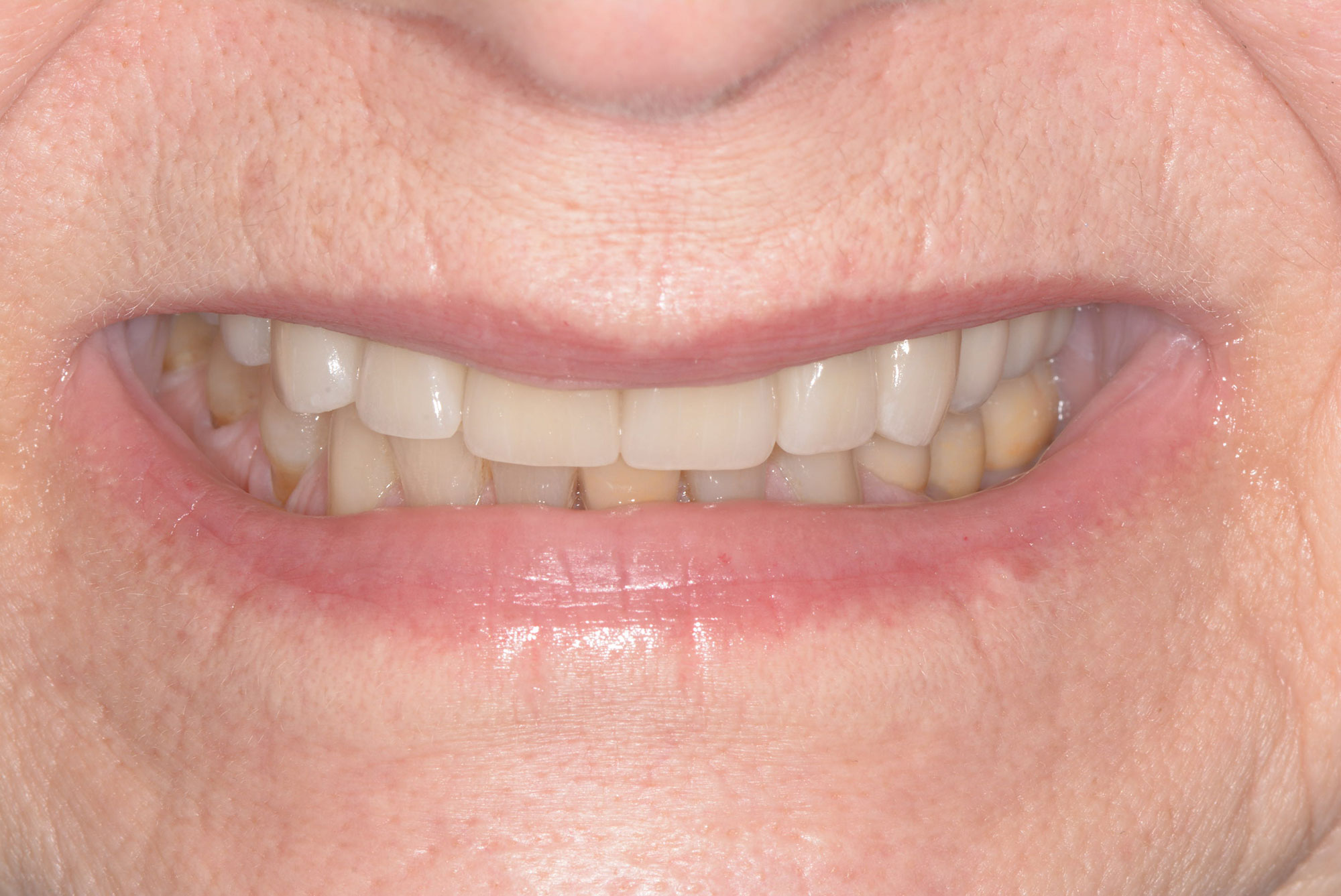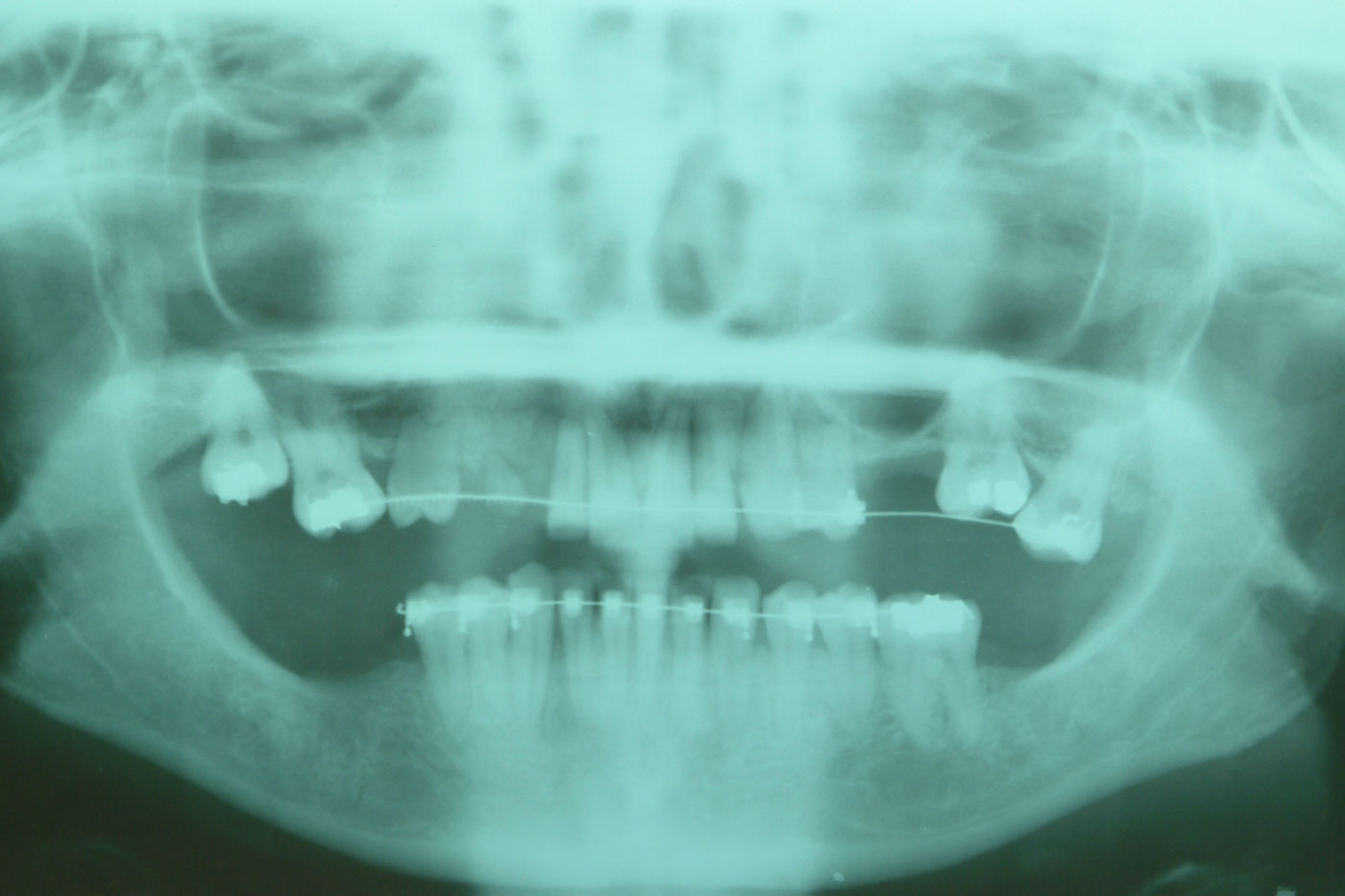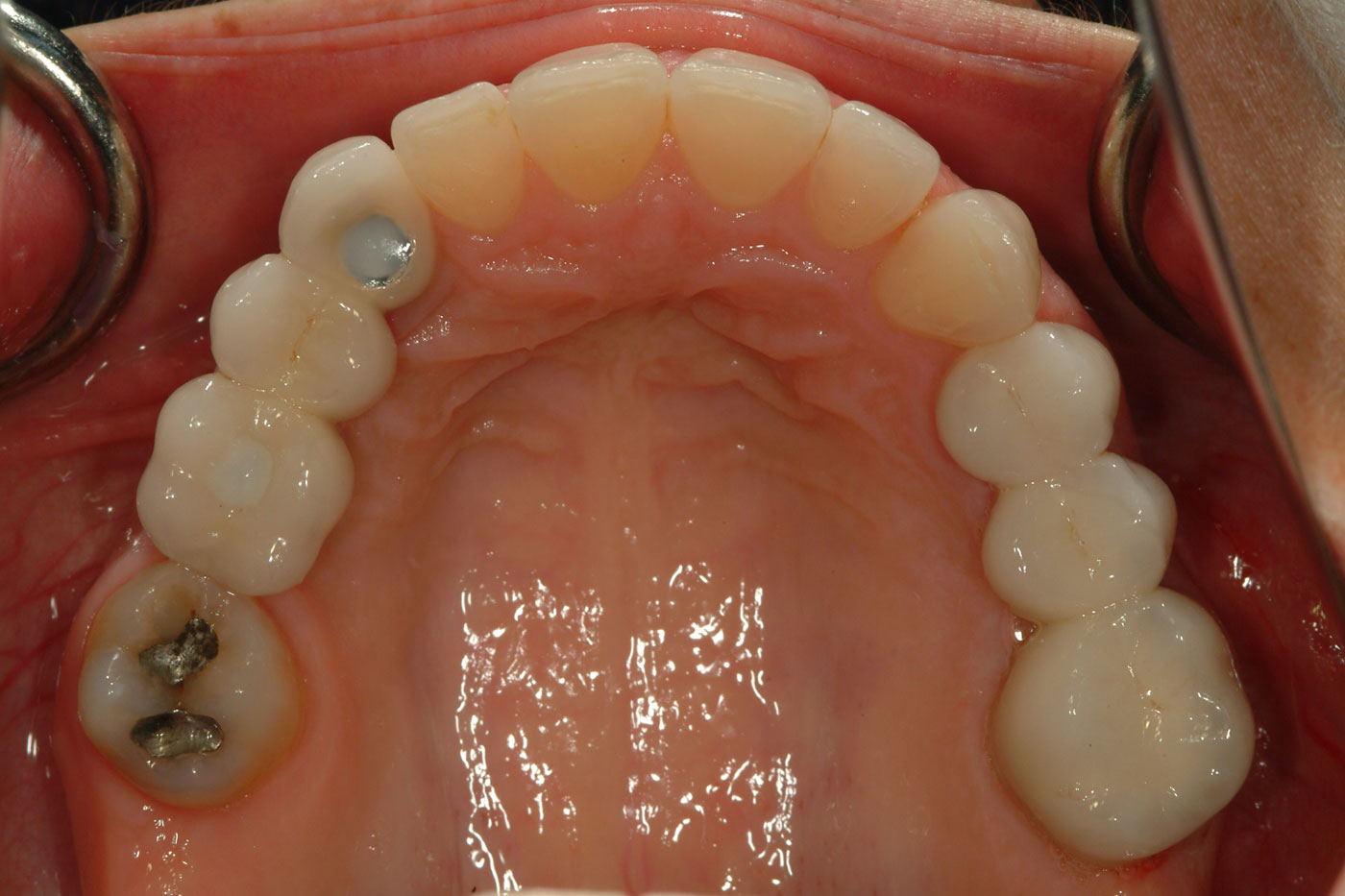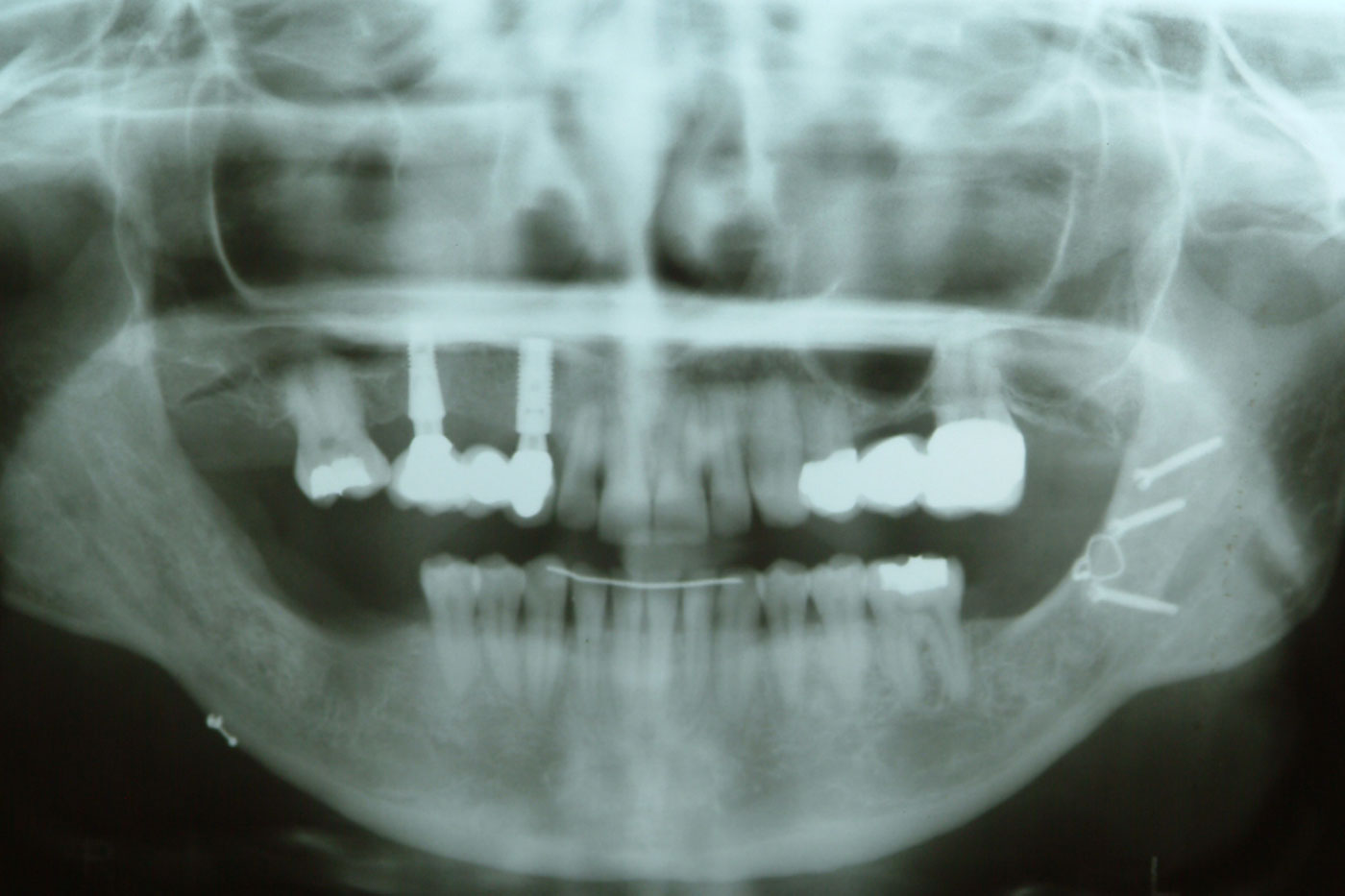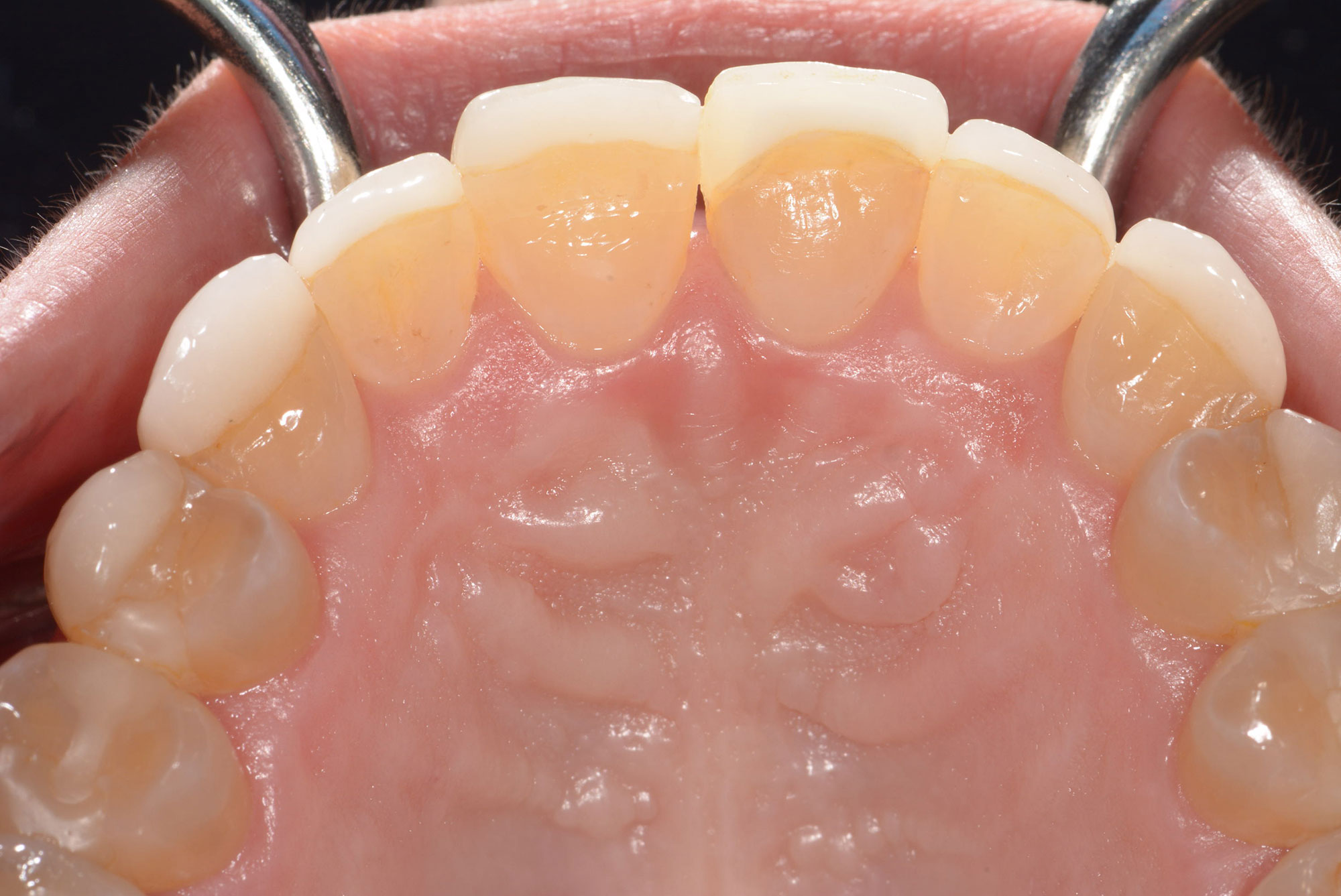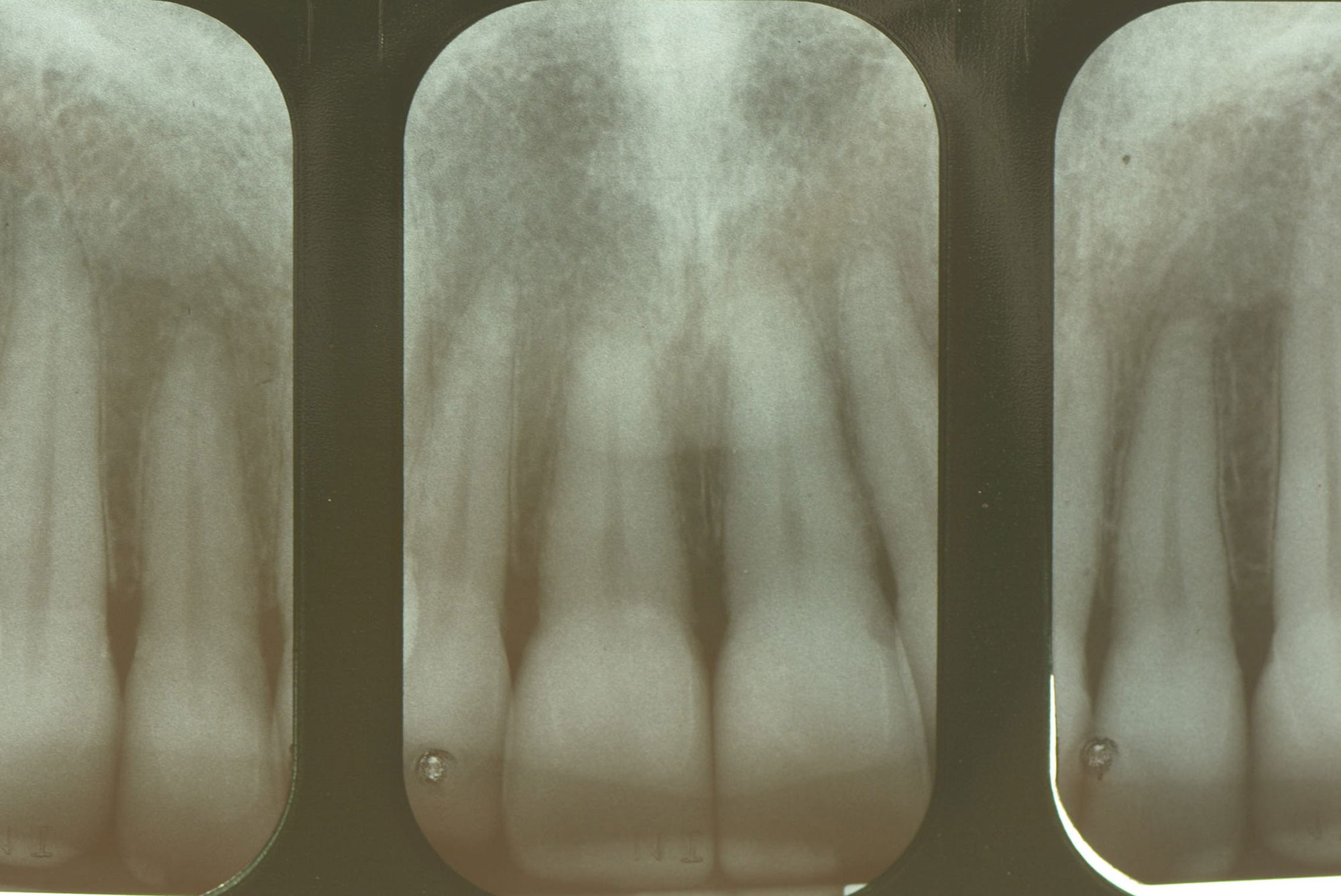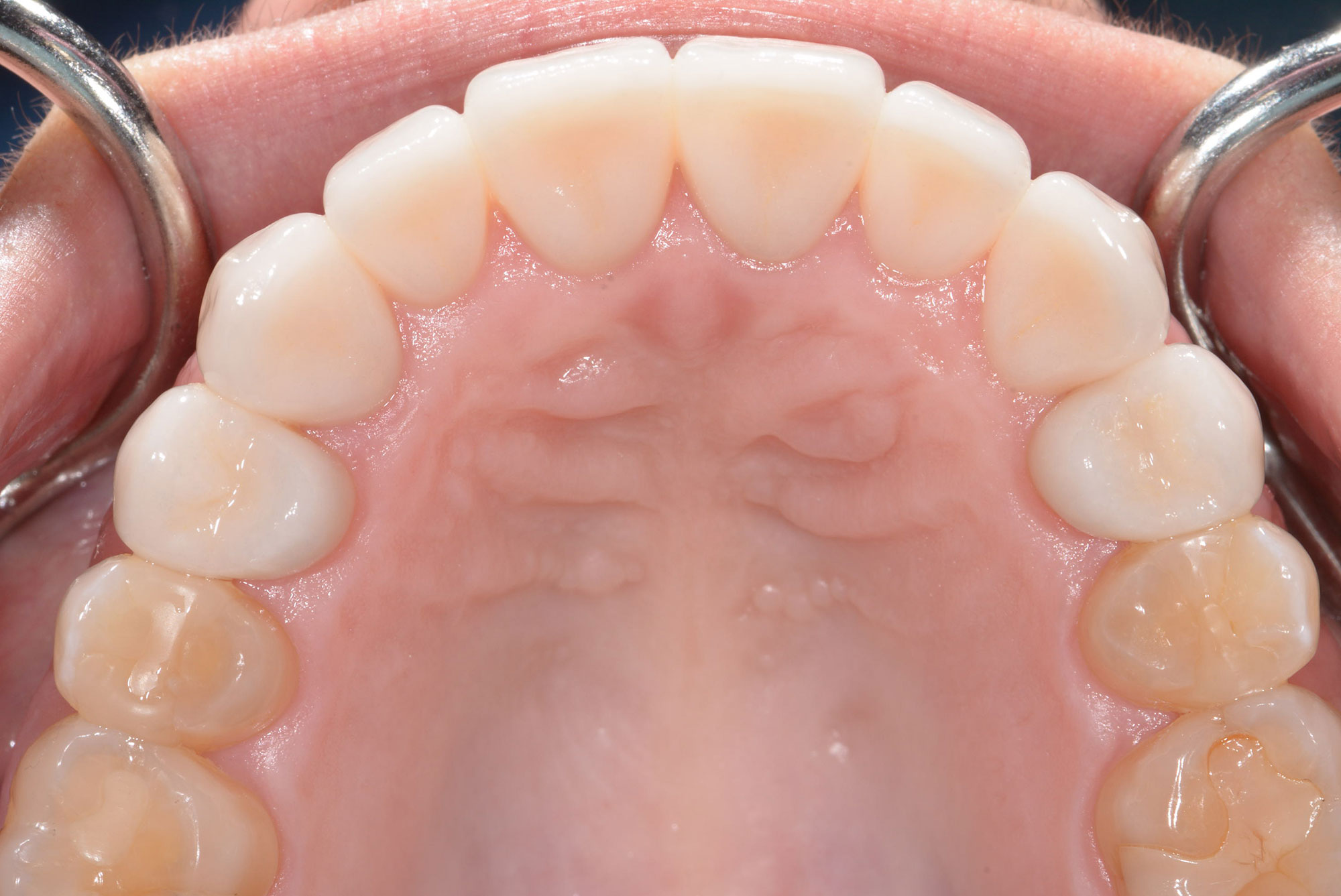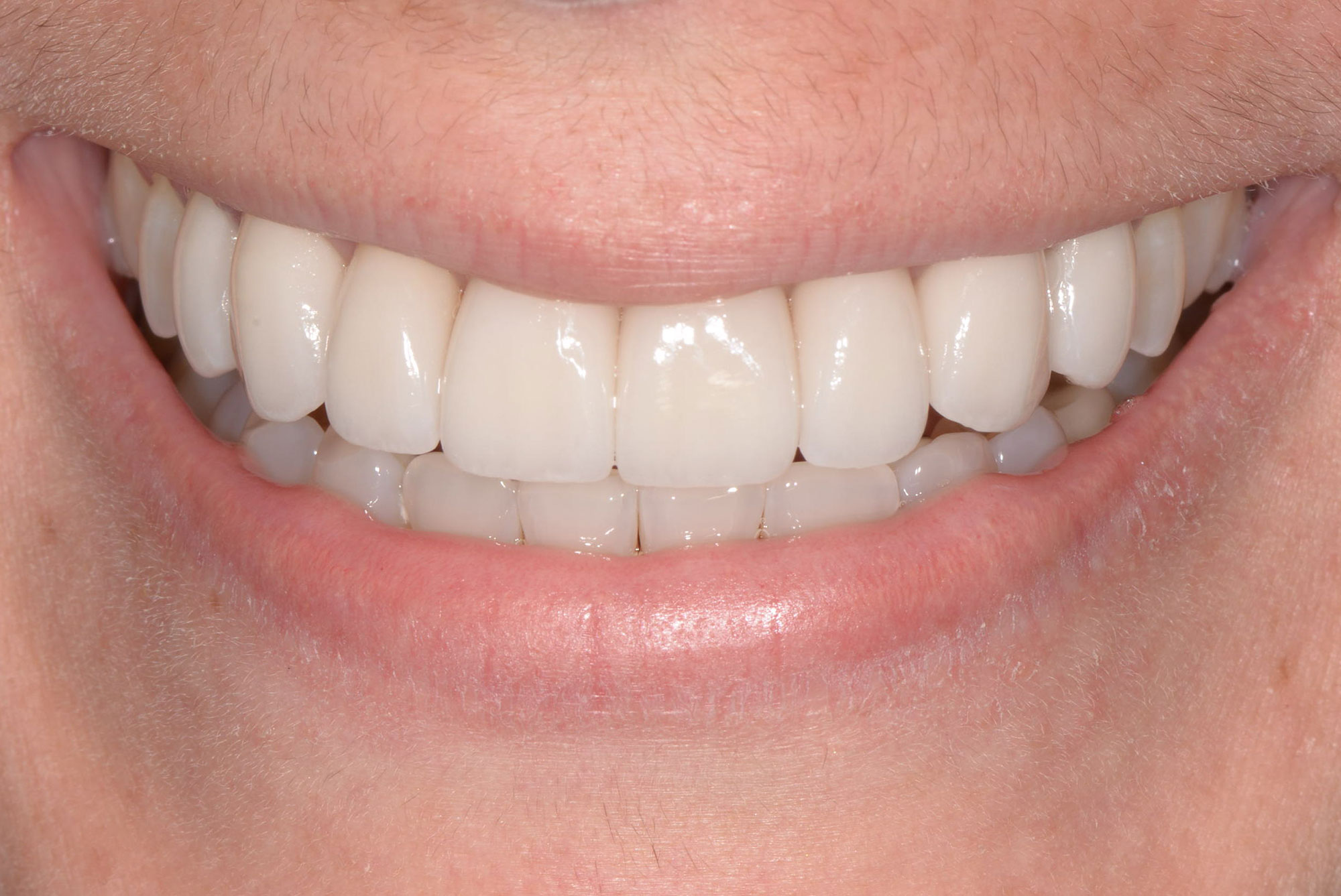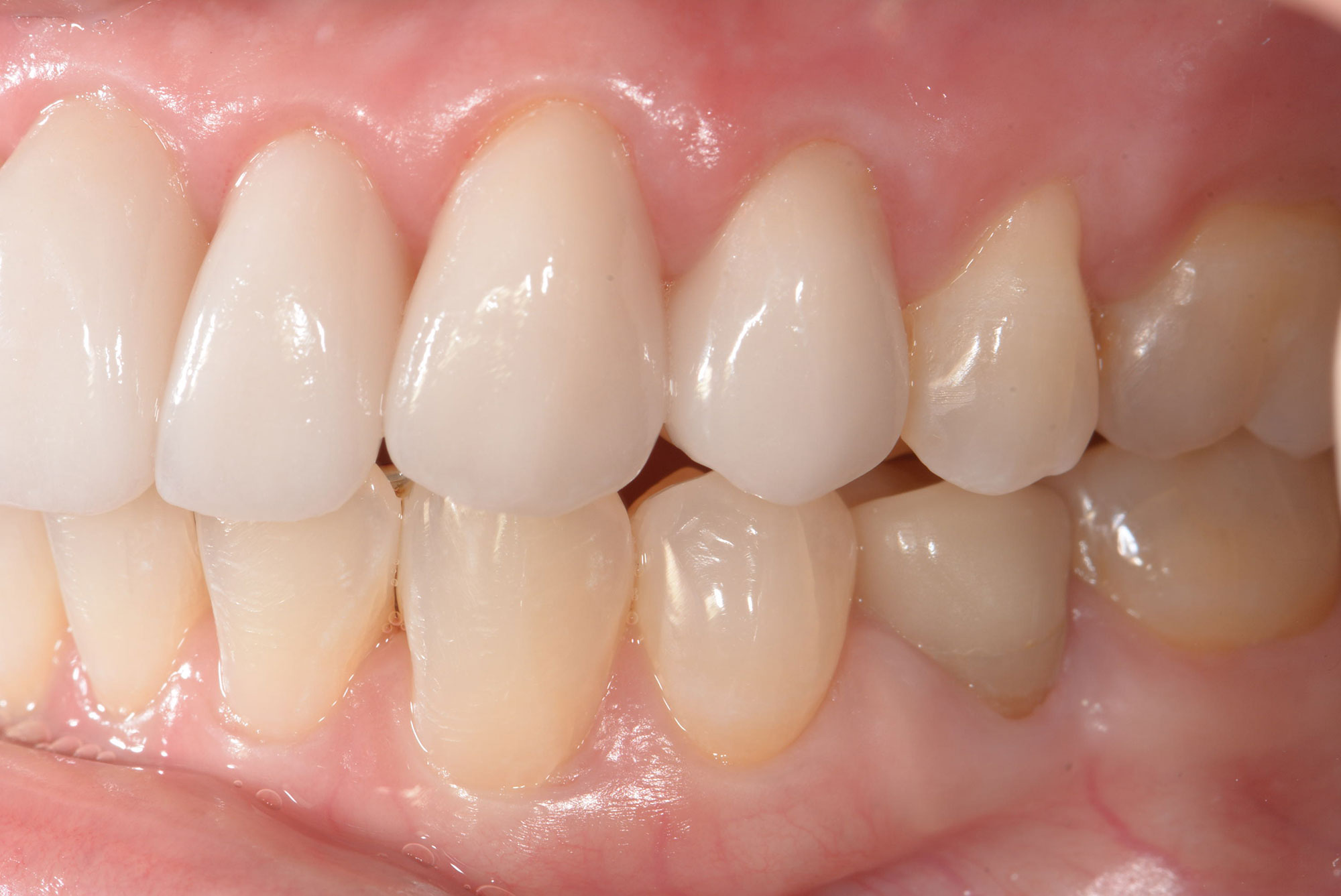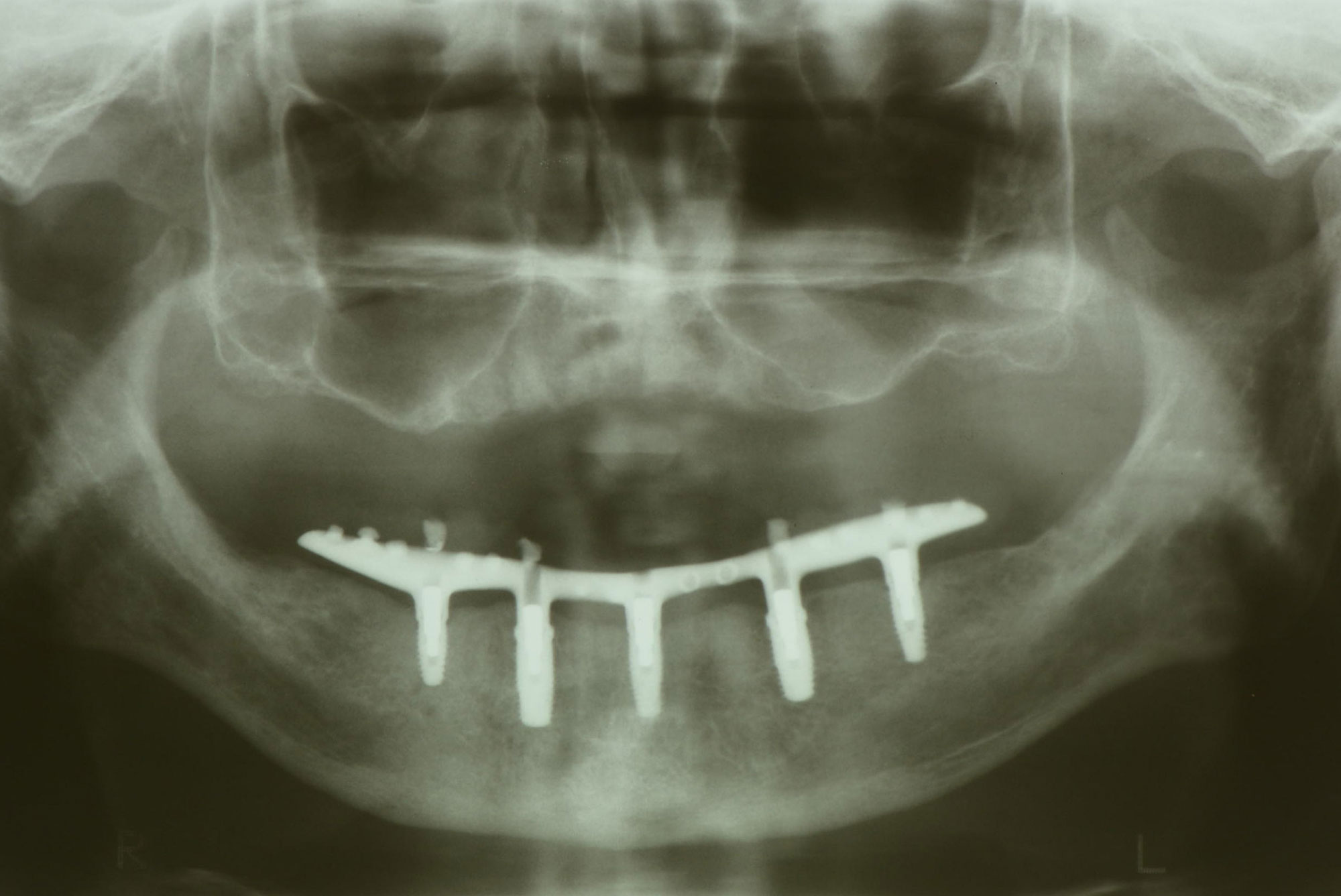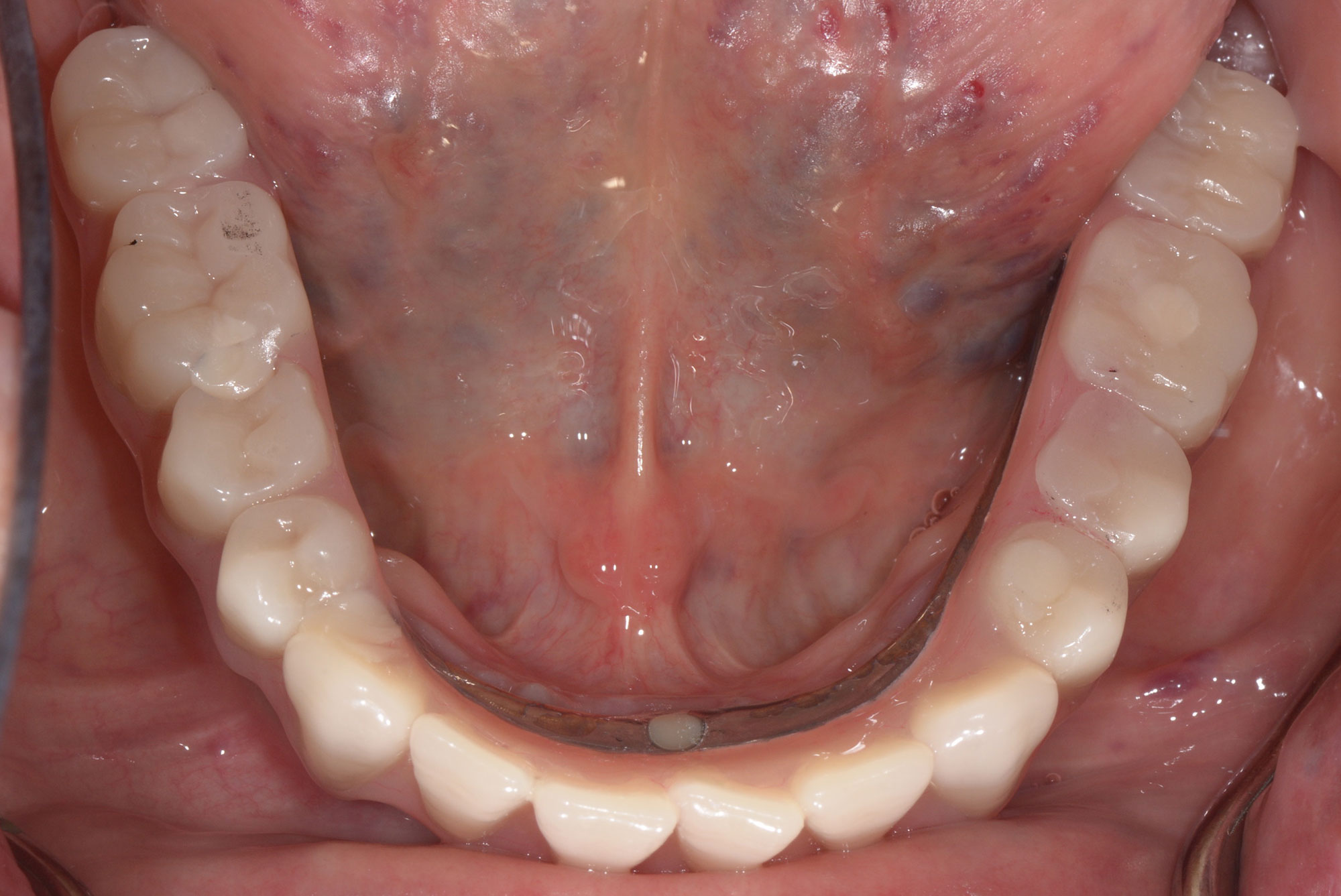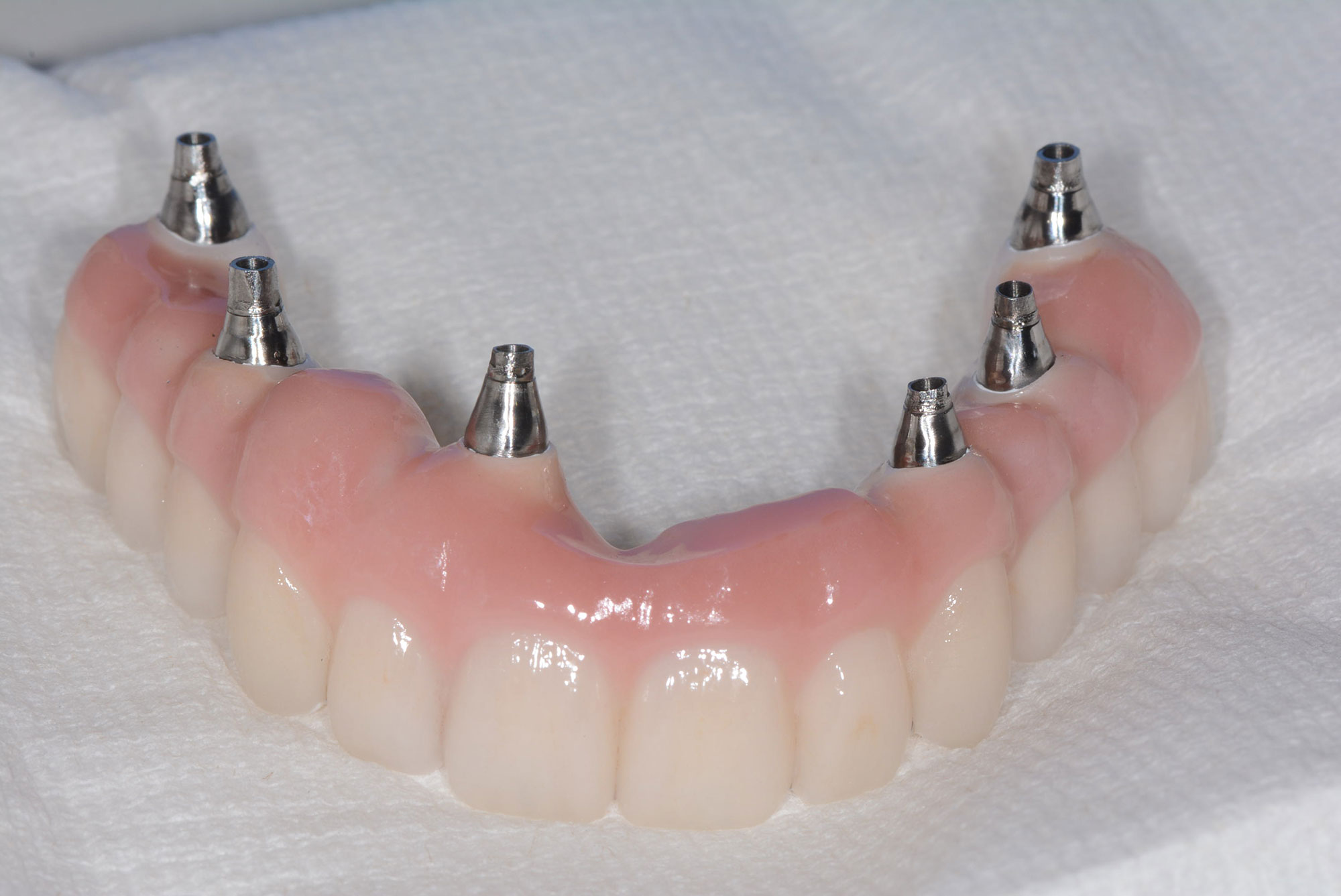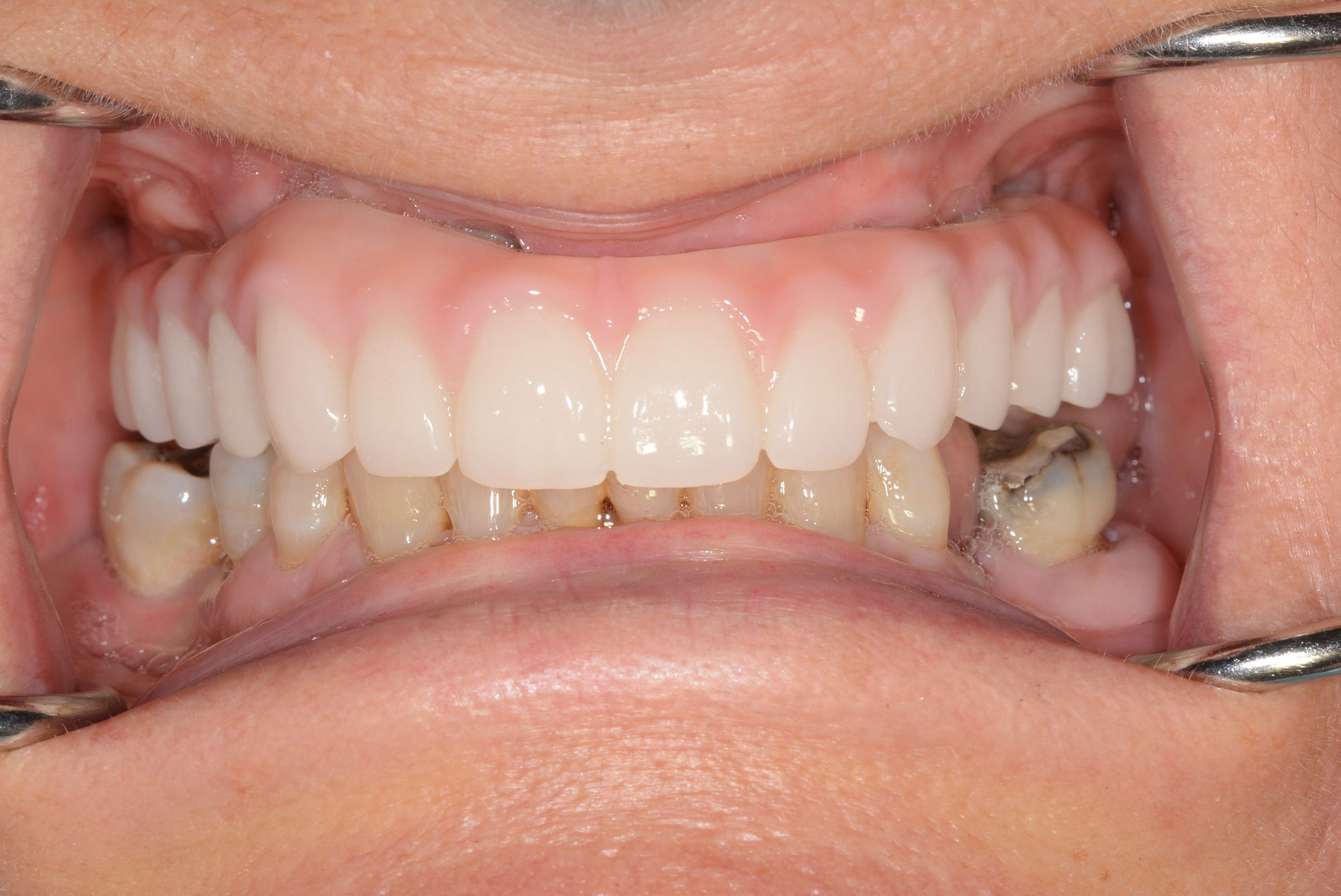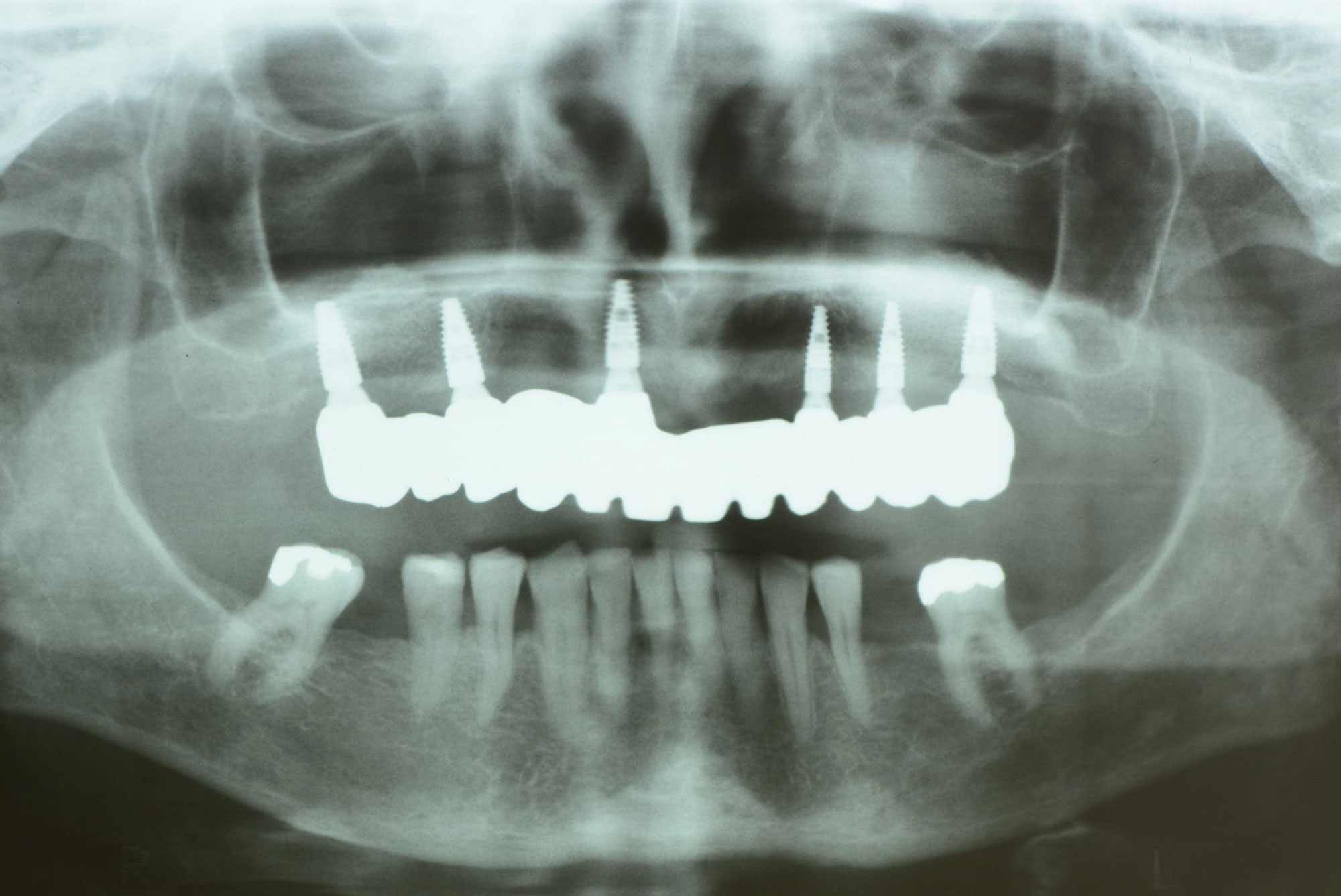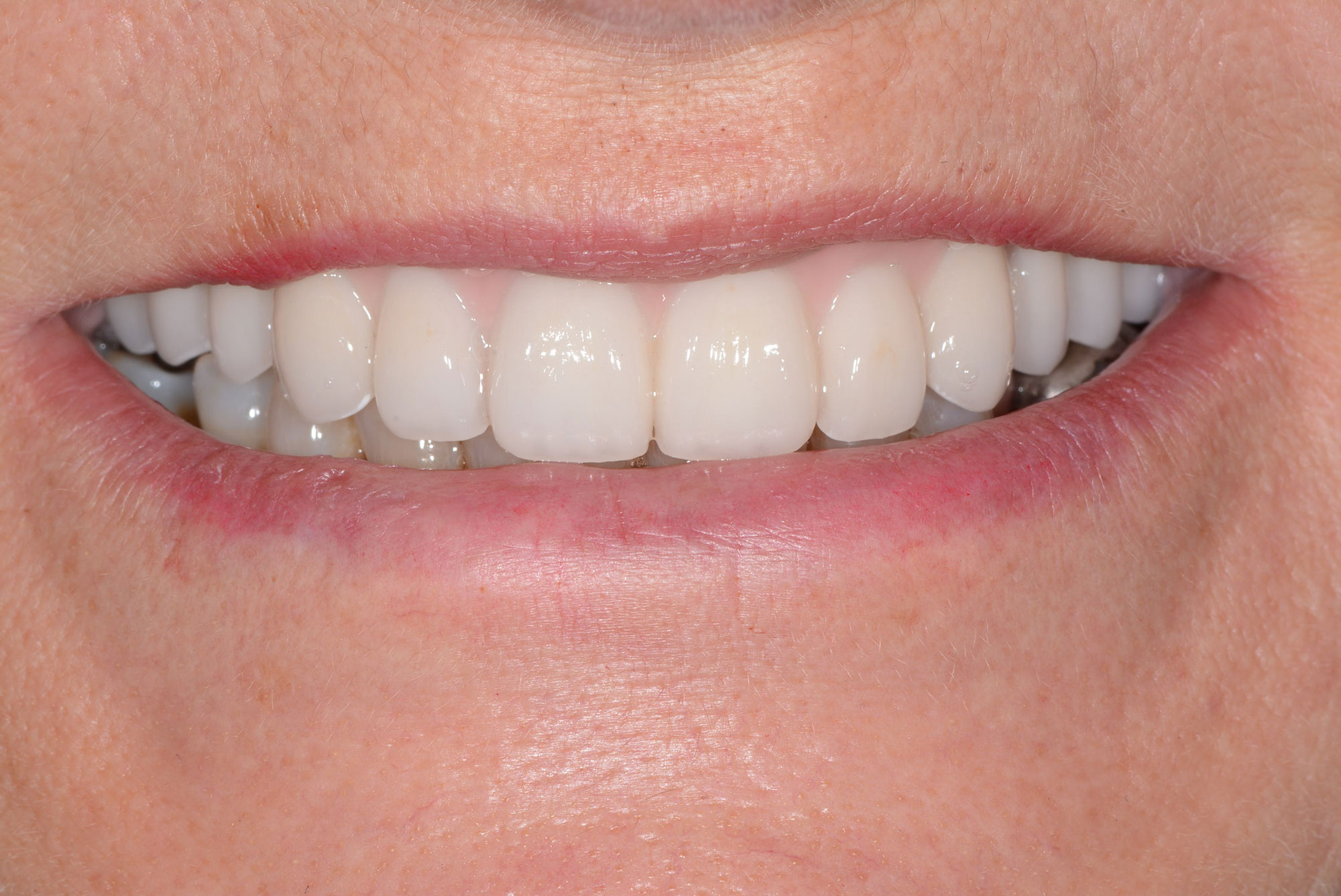Examples of solutions
Imitating nature
Here are a few clinical cases illustrating problems to be solved and possible prosthetic solutions.
Case 1
Two missing buds replaced by two implant-supported crowns
This young woman was referred by her orthodontist to replace two permanent premolars whose buds had never appeared. As the rest of her dentition was impeccable, a solution that did not involve the intact adjacent teeth was proposed: two implant-supported crowns.
Following integration of the titanium implants, the crowns were fabricated and placed in the mouth, according to the shades taken on site by our laboratory team.
Our patient is able to chew better, and now enjoys a more stable, gap-free dentition. She undergoes periodic preventive check-ups to verify the bone level of her implants and the integrity of her crowns.
Case 2
A resorbed tooth replaced by an implant-supported crown
This young man retained a primary tooth into adulthood, as the bud of the permanent tooth was absent. With the tooth now resorbed, a long-term permanent solution was needed to prevent dental migrations, such as extrusions or overlaps, and to maintain a good occlusion and well-aligned teeth.
Following integration of the titanium implant, a porcelain crown was placed on a titanium abutment. All according to the color and characterization tests carried out by our laboratory team. The hopeless, mobile primary tooth was replaced by an implant-supported crown.
Our patient now has a solid, comfortable and aesthetically pleasing tooth, just like his adjacent teeth. His missing bud is now a thing of the past. He is seen periodically as a preventive measure to check the bone level of his implant and the good condition of his porcelain tooth.
Case 2
A resorbed tooth replaced by an implant-supported crown
This young man retained a primary tooth into adulthood, with the permanent tooth bud absent. With the tooth now resorbed, a long-term permanent solution was needed to prevent dental migrations, such as extrusions or overlaps, and to maintain a good occlusion and well-aligned teeth.
Following integration of the titanium implant, a porcelain crown was placed on a titanium abutment. All according to the color and characterization tests carried out by our laboratory team. The hopelessly loose primary tooth was replaced by an implant-supported crown.
Our patient now has a strong, comfortable and aesthetically pleasing tooth, just like his adjacent teeth. His missing bud is now a thing of the past. He is seen periodically as a preventive measure to check the bone level of his implant and the good condition of his porcelain tooth.
Case 3
An all-porcelain « Envelope » to restore a damaged central tooth
Around the age of 12, this young girl suffered a major enamel fracture of one of her central teeth. Her general dentist maintained the health and appearance of her tooth with a direct composite resin restoration. This first restoration has the advantage of being shaped promptly following trauma, and helps to maintain spaces with the other teeth and surrounding tissues during this period of jaw growth. Now an adult, this young woman wants a more durable solution that simulates the aesthetics of her adjacent teeth as closely as possible.
Preservation of dental tissue is always taken into consideration when choosing the wisest option for a specific situation. When composite resin replaces a large portion of a tooth, a long-term, minimally invasive solution is needed to prevent breakage or progressive discoloration of the resin. All this while preserving maximum tooth structure. The latest advances in biomaterials, combined with meticulous laboratory control, enable us to offer porcelain envelope crowns that are thin and strong, yet visually very similar to natural enamel.
A minimally invasive « Envelope » crown was placed in the mouth. This is quite different from the first generation of crowns: it requires less reduction of the underlying tooth and reveals a translucency very close to natural enamel, even on post-operative X-rays.
Complete coverage of the damaged tooth with an all-porcelain crown provides confidence and durability. Our patient now reveals a radiant smile with no discoloration.
Want to see more?
Additional case studies
This highly motivated, still active, mature woman had always wanted to restore her teeth worn down by bruxism and reduce their misalignment. In addition, over the years, several lower teeth had been extracted and replaced with removable partial dentures. She wanted to improve her appearance and no longer have to wear a removable appliance. To reduce treatment time, she wanted a correction that did not involve orthodontic treatment.
In this case, planning of crowns for almost all the teeth present on the upper arch would allow her to regain more functional and aesthetic dimensions and shapes. For the missing lower teeth, new titanium roots were placed to support implant-supported fixed crowns and bridges.
In accordance with the treatment plan, we first verified the target parameters using provisional restorations, which were fabricated by our laboratory team and then adjusted in the mouth. Subsequently, fixed porcelain restorations were placed in the mouth, on the upper natural teeth and on the lower dental implants. Considering the patient's tendency to grind her teeth, a protective occlusal splint, to be worn during sleep, was fitted to protect her new rehabilitation.
Our patient got the dental rehabilitation she had long dreamed of. She feels great, her mouth is healthier and she chews better. Congratulations to our dear lady for her beautiful smile!
Having first completed orthodontic treatment, this woman now needed to find a solution to replace several missing teeth in the upper jaw.
Clinically, the right side showed mutilated or too-short roots. However, bone availability was favorable for the placement of at least two dental implants. On the left side, the situation was quite different: poor bone availability due to a maxillary sinus requiring bone grafting complicated implant placement. Fortunately, the teeth adjacent to the space to be filled were strong and provided ideal support for a fixed bridge cemented onto them.
What was the best solution for this patient?
After outlining the advantages and disadvantages of each alternative, she chose to proceed with an implant-supported bridge on the right and a bridge over natural teeth on the left. Solutions for replacing missing teeth are specific to each patient. Here, the patient's clinical situation and expectations determined the choice of treatment for her.
This young woman with a generous smile consulted us because she was experiencing episodes of detachment from her porcelain veneers. She wanted a more reliable treatment while optimizing the aesthetics.
Preservation of dental tissue is always taken into consideration when choosing the wisest option for a specific situation. With some veneers damaged or re-bonded, a long-term, reliable and minimally invasive solution was needed to prevent further breakage or delamination. All this while preserving maximum tooth structure. The latest advances in biomaterials, combined with meticulous laboratory control, enable us to offer porcelain envelope crowns that are thin and strong, yet visually very similar to natural enamel.
After listening to the patient's expectations, we verified the parameters targeted for final restorations, using provisional restorations that were fabricated by our laboratory team and then adjusted in the mouth. Subsequently, minimally invasive « Envelope » crowns were placed in the mouth. These are very different from the first generation of crowns: they require less reduction of the underlying teeth and reveal a translucency very close to natural enamel, even on post-operative X-rays.
Our patient now has confidence in her restorations: the full coverage gives her reliability. The choice of an all-porcelain rehabilitation enhances her radiant smile.
This very social man in his sixties complained of difficulty chewing properly and wanted to improve the appearance of his smile. He was missing several natural teeth, and his remaining teeth were also badly mutilated. What's more, his upper fixed bridges replaced only his anterior teeth.
The proposed solution was a fixed lower denture (supported by implants) and a removable full upper denture (without implants).
The patient was accompanied to coordinate the course of treatment during the provisional, surgical and prosthetic phases. The compromised teeth were replaced with a few solid, more evenly distributed implants. Once the titanium implants had been integrated and the tissues had healed properly, the final fixed lower and removable upper prostheses were placed in the mouth, based on preliminary trials carried out with our laboratory team.
Our patient's dental infections are cured and he enjoys better oral health. He's now proud of his smile and can chew his favorite foods better. He is seen periodically as a preventive measure to check the bone level of his implants and the progress of his prostheses.
This naturally smiling woman never really accepted the loss of her natural upper teeth due to terminal peridental damage. In her eyes, a full upper denture was a highly artificial replacement for her original teeth. She didn't want to have to remove her teeth before bedtime, and she wanted to rediscover the pleasures of functioning and smiling more naturally.
The examinations confirmed the presence of a sufficient bone base to plan a fixed implant solution. The patient was accompanied to coordinate the course of treatment during the provisional, surgical and prosthetic phases. Missing teeth were replaced with a few solid, well-distributed implants. Once the titanium implants had been integrated and the tissues had healed properly, the final prostheses were placed in the mouth in accordance with the preliminary trials tested in the mouth and carried out with our laboratory team.
Our patient has improved oral health. She is now happy with her smile and can chew her favourite foods better. She undergoes periodic preventive check-ups to verify the bone level of her implants and the integrity of her fixed bridges.
Patients experiencing difficulties with their dental health can be in many different situations. For this man in his fifties, his dental problem was caused by widespread loss of the marginal bone supporting his natural teeth. As a result, all his teeth became increasingly mobile. His bone loss was very advanced. The patient could no longer function properly because several teeth were uncomfortable or infected. Complete edentulism was inevitable, and a comprehensive solution had to be found.
In keeping with his budget, and in order to restore maximum quality of life and social dignity at the lowest possible cost, the upper teeth were replaced with a removable full denture. To replace the lower teeth, a removable full denture was stabilized with a machined titanium bar, held in place by two dental implants. The benefits for him are many: removal of hopeless teeth, improved appearance and preservation of the bone ridge near the lower implants.
In the long term, implants placed in bone are highly durable and have the potential to last the patient's lifetime. The machined titanium bar should last for several cycles of removable prostheses. Finally, acrylic removable prostheses should be renewed every five to ten years, depending on the patient's clinical situation, the forces exerted and the wear observed.
Our patient's dental infections are cured and he enjoys better dental and overall health. He's happy with his smile and can enjoy a much better function than if he'd remained completely toothless. He is seen periodically as a preventive measure to check the bone level of his implants and the progress of his prostheses.
With or without reference
For functional and aesthetic restoration of your mouth
A consultation with Dr. Chartrand lasts between 45 minutes and 1h15.
In preparation for your consultation, we have prepared a form for you to fill in, so that we can prepare for your examination and present you with solutions specific to your situation. This personalized consultation is also an opportunity to answer any questions you may have.
You can make an appointment in the way that suits you best :
Clinique de prosthodontie du West-Island
Dr. François Chartrand, D.M.D., Dipl. Prostho., Prosthodontist
755, blvd Saint-Jean, office 206
Pointe-Claire (Quebec)
H9R 5M9
P 514 630-6620
Business Hours
Care is provided from Tuesday to Thursday, starting at 8am.
Amenities
Free parking
Free Wi-Fi

